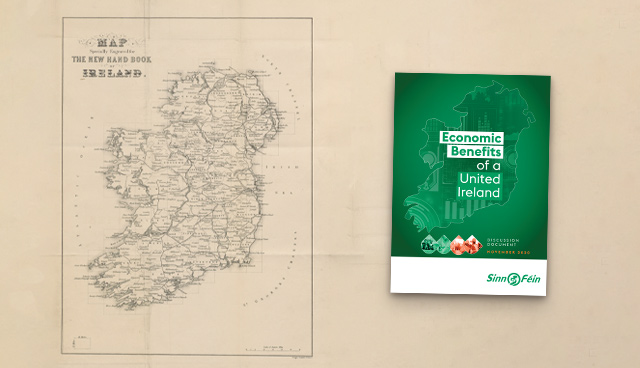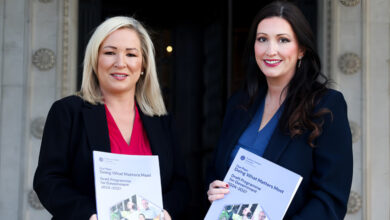The cost of partition

A United Ireland could cost as little as one per cent of the Republic of Ireland’s annual economic output, a new policy paper by Sinn Féin has stated.
While there are many facets to long-standing conversations about the viability of Irish unity, one consistent theme is that of the cost. Those opposed to or indeed indifferent to reunification tend to look at the costs that would be incurred, with many settling on a rough £10 billion subvention required from the UK for Northern Ireland’s economy annually. Those in favour tend to look at the potential benefits of an all-island economic approach, which would outweigh any incurred cost.
Consensus on the cost does not exist and the absence of consensus remains a stumbling block for those looking to further the discussion on the economic benefits reunification could bring across the island of Ireland.
As the economic impact of Covid-19 coupled with economic detriments Brexit emerge, the conversation on the viability of a reunification has intensified. Recognising this, Sinn Féin’s November 2020 policy paper entitled ‘Economic Benefits of a United Ireland’, claims to challenge the “existing narrative” that the Irish State cannot afford Northern Ireland and that a United Ireland is not economically viable.
A standout figure in the document is the analysis of subvention required for Northern Ireland, essentially, the spending gap currently plugged by the UK Government that would be required to be taken on by the Irish Government. In 2018–19, expenditure in Northern Ireland, calculated by that on services and of accounting adjustments was £27.888 billion, in contrast to revenue raised which was £18.5 billion, leaving a calculated subvention gap of between £9–10 billion.
However, Sinn Féin argues that this figure is an inaccurate reflection of the true cost and does not distinguish between spending on services within Northern Ireland (identifiable spending) and those British spending priorities for which costs are passed to Northern Ireland (non-identifiable spending) such as funding the military, paying down national debt or overseas commitments. Removing non-identifiable spending (£2.1 billion in 2018–19) would reduce the subvention figure to £6 billion.
This again, could be reduced further when considering that £3.5 billion is spent on pensions, an expenditure that should not have to be incurred by the Irish State because pension rights have already been accrued under national insurance contributions. “The ultimate subvention figure will be determined by the outcome of negotiations. This figure will range from between £2.5 billion to £6 billion,” the document states.
For context, the analysis highlights that this figure equates to just 1.3 to 3 per cent of output of the Irish economy in 2019 (€213.7 billion GNI* in 2019).
Cost alone should not be the only consideration when looking at reunification, Sinn Féin argues, pointing to the economic benefits of an all-island approach. Partition, it states, has left the Northern Ireland economy as the slowest growing economy on these islands, with 20 per cent of workers earning less than a basic living wage.
“It is recognised that having decisions taken in Westminster has been to the economic detriment of the North… the OECD categorised the North as essentially ‘peripheral with respect to its political influence’ on Westminster for innovation-related policies,” the document states, pointing to the benefit of an united Ireland allowing for the development of a development of “bespoke localised macroeconomic strategy”.
The border
The area to potentially benefit most from reunification is the border region, according to the analysis, which sets out: “Since partition the border corridor has effectively been consigned to periphery status limiting the economic potential of a significant section of our island and therefore of the whole island economy.”
Productivity in the southern part of the border region sits at 54 per cent of the island average and just 61 per cent of high-income European economies. “It is a region that should be heavily integrated and coordinated for its largest economic sectors… however, it is divided by two different currencies and two states competing for investment and economic activity,” the report says.
“Partition has trapped the border region in a vicious cycle… reunification would allow for more coordinated and strategic economic development across the island and especially within the border region, attracting more investment, improved productivity, and with it enhanced essential infrastructure.”
The EU
Underpinning their analysis of the economic detriments of Brexit, Sinn Féin emphasise the EU assertion in April 2017 that in the event of reunification, Northern Ireland would automatically re-enter the European Union.
In flagging economic analysis of severe-long-term reductions in output of the Irish economy in the decade or more after a hard Brexit of between 2.3 and 7 per cent, it adds that analysis of the current trading relationships between the islands of Great Britain and Ireland, in all circumstances, increased non-tariff barriers and increased administration burdens will apply for firms and across Britain and potentially in Ireland.
The analysis recognises the Irish protocol’s role in mitigating the threat of severe disruption on cross-border trade, important when considering that some £4.2 billion was exported by businesses in Northern Ireland to the south.
Accepting that how trade between Northern Ireland and Great Britain will be affected remains unclear, the paper seeks dispel the assumption that Britain is Northern Ireland’s most valuable trading partner, believing that this is based solely on the value of trade being higher, and that this overlooks the fact that more businesses trade north to south than north to Great Britain and the role of north south supply chains and intermediary trades prior to any sale from Northern Ireland to Great Britain.
“The assertion that trading between the North and Britain would be negatively impacted or that the North has more to lose in terms of trading with Britain in the context of Irish unity is debateable and can be rebutted in numerous ways,” it states, pointing to the threats of Brexit, including customs costs and barriers on Northern Ireland exports to Great Britain and evidence that, even in advance of tariffs, Northern Ireland’s businesses are becoming less reliant on trade with Great Britain (NISRA figures show a 9.3 per cent decrease in 2018).
Evidence of this, it suggests, is that in 2018, for the first time since records began, Northern Ireland exported more goods to other countries (£11.2 billion) than to Britain (£10.6 billion).
Summarising, it states: “Reversing the negative effects of Brexit is an economic necessity. Irish unity would allow the North to enjoy full benefits of EU membership including access to the European market and to substantial funding, and the investment opportunities offered through EU programmes and institutions, while enabling further all-Ireland integration.”
Energy
An area where the discussion paper is less assertive is on the “potential of the green economy”. In the absence of concrete figures on potential economic benefits, it instead discusses Ireland’s underperformance in developing a green economy to date and points to “untapped avenues”.
Ireland’s Single Electricity Market (SEM) could have been pointed to as an example of where all-island integrated policy has proven to be beneficial and could serve as a template for wider green initiatives. However, the document does recognise the unique challenges facing Northern Ireland due to the absence of fiscal levers in meeting climate obligations.
“Irish unity is the route through which economic benefits of the necessary transition including green jobs and greater security of energy supply can best be realised. The benefits from economies of scale and all-island spatial planning apply equally to the green economy,” it states.
“Partition means that the benefits of a transition to a zero-carbon economy will be dampened significantly, as both parts of the island compete against each other for private renewables investment while operating two incoherent and potentially conflicting green economic agendas.”
In concluding, Sinn Féin says that the document serves to advance the economic case that the entire island of Ireland will benefit economically from unity. “It is not a question about whether we can afford Irish unity, the fact is that we cannot afford partition.”





